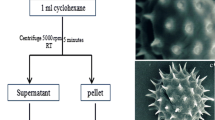Abstract
ANGIOSPERM pollen grains carry extracellular proteins in two sites: in the inner wall layer, the cellulosic intine, and in cavities in the outer exine, the sculptured part of the wall composed of sporopollenin1–3. The intine proteins, which include several acid hydrolases, are synthesised by the spore and inserted during growth; they are therefore gametophytic in origin. The exine proteins, in contrast, are produced in the tapetum, the nurse tissue of the anther, and injected into the exine cavities during the maturation of the pollen grains; they are thus sporophytic. The enzymic wall proteins seem to be concerned with germination, penetration of the stigma surface and the early growth of the pollen tube. Other fractions are involved in the recognition responses which control breeding behaviour, playing a part in both interspecific4 and intraspecific5,6 incompatibility systems.
Similar content being viewed by others
References
Knox, R. B., and Heslop-Harrison, J., Nature, 223, 92 (1969).
Knox, R. B., and Heslop-Harrison, J., J. Cell Sci., 6, 1 (1970).
Heslop-Harrison, J., Heslop-Harrison, Y., Knox, R. B., and Howlett, B., Ann. Bot., 37, 403 (1973).
Knox, R. B., Willing, R. R., and Ashford, A. E., Nature, 237, 381 (1972).
Heslop-Harrison, J., Knox, R. B., and Heslop-Harrison, Y., Theor. appl. Genet. (in the press).
Dickinson, H. G., and Lewis, D., Proc. R. Soc., B 183, 21 (1973).
Linskens, H. F., and Kroh, M., Handb. Pfl. Physiol., 18, 506 (Springer Verlag, Berlin, 1967).
Lewis, D., Genetics Today, 3, 657 (Pergamon, London, 1965).
Heslop-Harrison, J., and Heslop-Harrison, Y., Stain Technol., 45, 115 (1970).
Jensen, W. A., Botanical Histochemistry (Freeman, San Francisco, 1962).
Pearse, A. G. E., Histochemistry: Theoretical and Applied, 2 (Churchill, London, 1972).
Barka, T., and Anderson, P. J., J. Histochem. Cytochem., 10, 741 (1962).
Knox, R. B., and Heslop-Harrison, J., J. Cell Sci., 9, 239 (1971).
Knox, R. B., J. Cell Sci., 12, 421 (1973).
Green, J. R., Ann. Bot., 8, 225 (1894).
Linskens, H. F., and Heinen, W., Z. Bot., 50, 338 (1962).
Author information
Authors and Affiliations
Rights and permissions
About this article
Cite this article
MATTSSON, O., KNOX, R., HESLOP-HARRISON, J. et al. Protein Pellicle of Stigmatic Papillae as a Probable Recognition Site in Incompatibility Reactions. Nature 247, 298–300 (1974). https://doi.org/10.1038/247298a0
Received:
Issue Date:
DOI: https://doi.org/10.1038/247298a0
- Springer Nature Limited
This article is cited by
-
Self-incompatibility: a targeted, unexplored pre-fertilization barrier in flower crops of Asteraceae
Journal of Plant Research (2023)
-
Selenium supplementation to lentil (Lens culinaris Medik.) under combined heat and drought stress improves photosynthetic ability, antioxidant systems, reproductive function and yield traits
Plant and Soil (2023)
-
Evaluation of stigma receptivity and its properties in Helianthus annuus L. (Asteraceae)
Vegetos (2022)
-
Nitric oxide secures reproductive efficiency in heat-stressed lentil (Lens culinaris Medik.) plants by enhancing the photosynthetic ability to improve yield traits
Physiology and Molecular Biology of Plants (2021)
-
COPI complex isoforms are required for the early acceptance of compatible pollen grains in Arabidopsis thaliana
Plant Reproduction (2020)





